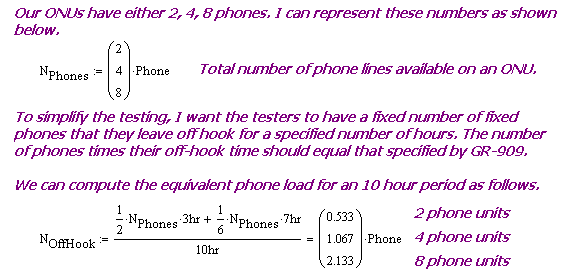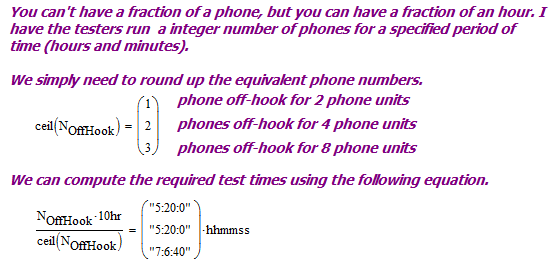Introduction
I often have to assist with writing test procedures. One of our procedures involves testing the battery backup time for the equipment we install at the subscriber’s home, which is called an Optical Network Unit (ONU). Nearly all ONUs installed in the United States are installed with an Uninterruptible Power Supply (UPS) because phone service in the US is considered a safety-critical service, which means it must work during a power failure. Oddly enough, almost no ONUs installed internationally use a UPS and they simply use a “wall wart” for their power conversion.
The math in this post will be simple, but it is the sort of thing I end up doing all the time. Our customers need procedures that they can use to compute things like:
- battery backup time
- battery lifetime
- yearly power cost to subscribers (the homeowners pay for the ONU’s power)
In all these cases, I use weighted averages to simplify calculations or procedures. In the particular case that I am going to explain here, I will be using a weighted average to simplify a routine test procedure.
Background
Telecommunications service requirements in the US are still strongly influenced by the legacy of the Bell System. In the case of battery backup time, telecom companies expect their ONUs to have 8 hours of backup time when tested according to specifications from Telcordia, the company that now controls the old Bell System specifications. We use Telcordia specification GR-909 for backup time tests, which states (with some editing):
The system supplier shall specify the battery reserve time, multiplied by 0.8, obtained under the following conditions:
The ONU primary power source shall be removed. One-half of the equipped single-party message telephone lines shall be off-hook. After three hours, only one-sixth of the single-party message telephone service lines shall remain off-hook. The remaining lines shall be on-hook.
If you think it sounds complicated now, you should have seen it before I removed all the boiler plate.
Our customers expect a minimum of 8 hours of ONU backup time when tested according to this procedure. I interpret the procedure above to mean that I need to guarantee 10 hours of backup time with a new battery at this level of phone loading in order to claim 8 hours of backup time (10.0 hours · 0.8 = 8.0 hours). While this sounds odd, it is consistent because GR-909’s requires the replacement of any battery that has aged to less than 80% of it rated capacity. So GR-909 wants to ensure 8 hours of backup time even with an old battery. It also means that I always test with new batteries.
While we run this exact test procedure for final acceptance testing, we use a simplified procedure for routine prototype testing. We have seen that our simplified procedure always provides the same result as the specified procedure and it is simpler to execute in practice.
Simplified Procedure Derivation
Phones only put a significant load on a system when they are off-hook. It is a hassle for engineers to constantly put combinations of phones off-hook and on-hook at specific times. For prototype testing (i.e. not final acceptance tests), the easiest way for the testers to work is to put a specified number of phones off-hook for a specified amount of time and then put the phone back on-hook when that time is over.
To generate an equivalent load, I begin by computing the total phone load (phone · time) experienced by an ONU during testing. I then create a equivalent load profile that does not require the testers to worry about the details of phone ratios and times.
Figure 1 shows how I computed that effective number of off-hook phones for a ten hour period.
Since we cannot have a fractional phone but can have a fractional hour, we can compute how long to keep a number of phones off-hook in order to have the same loading as specified by GR-909 (see Figure 2).
All this means that we can get a GR-909 equivalent load by using the following procedure:
- For a 2 phone ONU → one phone off-hook for 5 hours and 20 minutes during the ten hour test.
- For a 4 phone ONU → two phones off-hook for 5 hours and 20 minutes during the ten hour test.
- For a 8 phone ONU → three phones off-hook for 7 hours and 6 minutes during the ten hour test.
Conclusion
This post illustrates how you can use a weighted average to compute the equivalent load of a more complicated test procedure. While it does not replace the more complicated procedure, it does provide a simple way to easily test prototypes prior to the final acceptance test.



